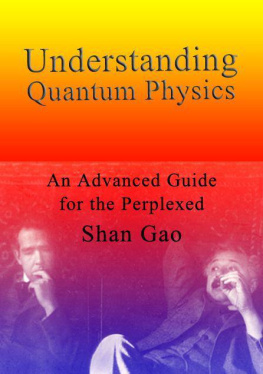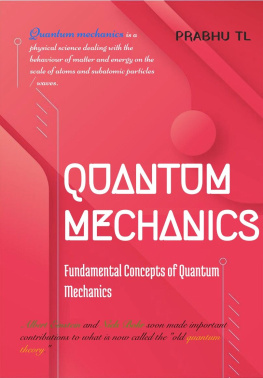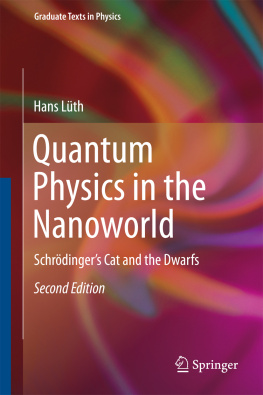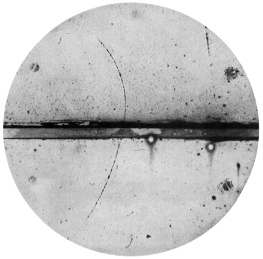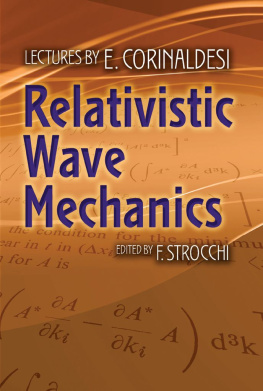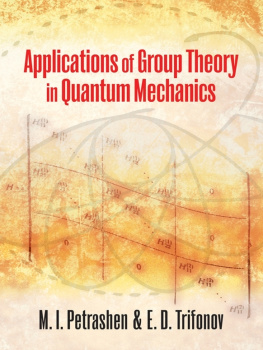Understanding
Quantum Physics
An Advanced Guide for the Perplexed
Shan Gao
Shan Gao 2011
All rights reserved
Published 2011
by Amazon Kindle Direct Publishing
www.amazon.com
This book is copyright. Subject to statutory exception and to provisions of relevant collective licensing agreements, no part of this publication may be reproduced, stored in a retrieval system, or transmitted in any form or by any means, without the prior written permission of the author.
This book is dedicated to Erwin Schrdinger, who introduced the wave function, discovered its equation named after him, and argued that quantum mechanics is incomplete by his famous cat paradox.
It has even been doubted whether what goes on in an atom can be described within a scheme of space and time. From a philosophical standpoint, I should consider a conclusive decision in this sense as equivalent to a complete surrender. For we cannot really avoid our thinking in terms of space and time, and what we cannot comprehend within it, we cannot comprehend at all.
Erwin Schrdinger
Someday we'll understand the whole thing as one single marvelous vision that will seem so overwhelmingly simple and beautiful that we may say to each other; "Oh, how could we have been so stupid for so long? How could it have been otherwise!"
John Archibald Wheeler
Contents
Acknowledgements
The idea of random discontinuous motion of particles came to my mind when I was a postgraduate at the Institute of Electronics, Chinese Academy of Sciences in 1993. I am happy that finally it has a more logical and satisfying formulation in this book. During the past twenty or so years, I have benefited from discussions with many physicists and philosophers of physics who care about the way the world really is. They are: Stephen Adler, Jacob Bekenstein, Samuel Braunstein, Jeremy Butterfield, Tian Yu Cao, Zexian Cao, Philippe Eberhard, Bernard d' Espagnat, Shelly Goldstein, Basil Hiley, Gerard 't Hooft, Sabine Hossenfelder, Chris Isham, Frederick M. Kronz, Gui-Lu Long, Alwyn van der Merwe, David Miller, Philip Pearle, Roger Penrose, Huw Price, Alastair Rae, Erasmo Recami, Dean Rickles, Abner Shimony, Henry P. Stapp, George Svetlichny, Antoine Suarez, Antony Valentini, Hans Westman, Christian Wthrich, Heinz-Dieter Zeh, and Anton Zeilinger, among others. I thank them all deeply.
My deepest gratitude goes to my parents, QingFeng Gao and LiHua Zhao, who spared no effort to provide the best possible environment for me to grow up in and their constant support during my extended studies. They have always allowed me to have the freedom of choice, and for that I am truly grateful. Finally, I am deeply indebted to my wife, HuiXia, and my daughter, Vicky, for their unflagging love and support throughout my study and writing; this book would have been impossible without them. Moreover, they have never let me forget the true values of life.
This book was support by a University of Sydney International Scholarship and a Postgraduate Scholarship in Quantum Foundations provided by the Unit for History and Philosophy of Science and Centre for Time of the University of Sydney, as well as by two Lucy Firth Scholarships in Philosophy provided by the Department of Philosophy of the University of Sydney. I would like to thank them for their kind support.
Shan Gao
Sydney
November 2011
A True Story of Quantum Exploration
An Excerpt from God Does Play Dice With the Universe
During my childhood, it had been a wonder for me that the twinkling stars strewed in the night sky don't fall to the Earth. I had a strong desire to know the whys and wherefores. Later I found the answer in textbooks. It changed my picture of the universe. When I was an undergraduate, I began to be entranced by the deep mysteries of the atomic world. I was especially stunned by the fact that the commonsense planetary picture of atoms turns out to be utterly false; the electron in an atom cannot rotate round the atomic nucleus as the Earth rotates round the sun, or else it would soon radiate its energy and fall into the nucleus, and as a result, my body composed of atoms would collapse in a blink. How does the electron move then? It must exist in the atom. It must move in some way there. But more surprisingly, textbooks provided no picture of the motion of the electron. On 22 August 1987, I wrote in my diary: "Is it really true that we have no way to describe the atomic processes as processes happening in space and time?" I could only search for the answer by myself. Then I started on a lonely journey to "trace" the elusive electron at the age of 16.
In order to find how the electron moves in an atom, I went to the Institute of Electronics, Chinese Academy of Sciences to pursue my graduate study. But it was according to expectation that nobody there could give me any tips either. I then spent nearly every day in musing on the seemingly indescribable motion of electrons. If a ball indeed moves in a continuous way, then it seems that an electron or an atom should also move in the same way. The ball is composed of atoms after all. But, on the other hand, if an electron moves continuously in an atom, it will soon fall into the nucleus, while the tragedy does not happen in reality. This is a great dilemma. I found some possible solutions, but they shortly proved to be wrong.
The puzzle had been plaguing me. Day after day, I gradually doubted the reality of continuous motion. But I still felt in my bones that the particles must move in some way. Finally, in the early morning of 12 October 1993, I experienced a sudden enlightenment. At that moment, I felt that my body permeated the whole universe and I was united with it. I "disappeared". A clear picture then appeared: a particle is jumping in a random and discontinuous way. It is not inert but active; it moves purely by its own "free will". Maybe God does play dice in the atomic world. I finally broke loose the tightest shackles of continuous motion with the help of inspiration. After this event, the outcome seems very natural from a logical point of view. If a particle cannot move continuously, it must move in a discontinuous way. How deep-rooted the prejudice of the uniqueness of continuous motion is!
If an atom moves in a random and discontinuous way, then it can easily pass through two slits at the same time. But why does a ball appear to move in a contrary way? Moreover, why on earth does God play dice? These puzzles further haunted me. After graduated from the Institute of Electronics, I decided to be an independent theoretical physicist, or more accurately, a natural philosopher who aims at understanding the mysterious universe. Life was not easy. But I never gave up my research, and I never stop thinking. It had become the theme of my life.
As time went on, the picture of random discontinuous motion became clearer and clearer in my mind. When I took a walk one afternoon in June 2001, I suddenly had another inspiration after long reflection in solitude and meditation. I realized that motion has no cause in reality, and thus it must be essentially random, i.e., God must play dice. Moreover, the familiar phenomenon of inertia has already revealed that a ball also jumps in a random and discontinuous way just like an atom. This is another new idea. Maybe the path to truth is always devious in order that surprise can hide at the turn waiting for persevering seekers. God also plays dice in our everyday world. He actually plays dice with the whole universe. What a harmonic world!
I simply want to know the answer of a naive question. I simply think on it continually. But the exploration has completely changed my life. It shapes my way through the world and finally leads me to God, the ultimate reality. As Trinity said in The Matrix, "Its the question that brought you here The answer is out there, Neo, and its looking for you, and it will find you if you want it to."
Next page
